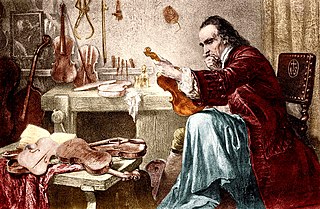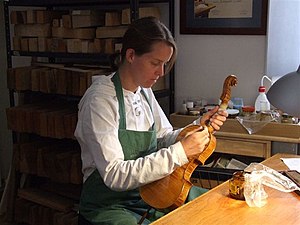Luthier
From Wikipedia, the free encyclopedia
| This article may require cleanup to meet Wikipedia's quality standards. Please improve this article if you can. (November 2006) |

A luthier (IPA: /ˈluːtɪə(r)/) is someone who makes or repairs stringed instruments. The word luthier comes from the French word luth which is French for "lute".
The craft of lutherie is commonly divided into two main categories: stringed instruments that are plucked or strummed, and stringed instruments that are bowed. While there is a nearly limitless variety of stringed instruments both historic and modern, from many places and cultures — the following lists give some examples of instruments in each category still in use today.[1]
In the first category are the: autoharp, banjo, bouzouki, charango, cittern, appalachian dulcimer, guitar, harp, kantele, kithara, kora, koto, lute, theorbo, archlute, angelique, torban, kobza, bandura, lyre, pipa, mandolin, oud, shamisen, sitar, ukulele, and veena.
In the second category are the: cello, crwth, double bass, erhu, fiddle, mouthbow, nyckelharpa, hurdy gurdy, rabab, rebec, sarangi, viol, viola, viola da braccio, viola d'amore, viola da gamba and violin.
Since bowed stringed instruments require a bow, this second category of luthier contains a subtype known as an "archetier", which is a French word for one who makes bows.[2] While the division of luthiers into two categories may seem arbitrary, there are those who are passionate about the difference between these categories.[3][4] For this reason, the remainder of this article will use the division for clarity and convenience.
Contents |
[edit] Plucked strings
[edit] Lutes
Important luthiers who specialized in the instruments of the lute family (lutes, archlutes, theorbos, vihuelas etc.):
- Tieffenbrucker family
- Sellas family
- Martin Hoffmann
- Joachim Tielke
- Leopold Widhalm,
- Sixtus Rauwolf
- Michele Harton
- Giovanni Tessler
- Sebastian Schelle
- Vendelio Venere
and in our time:
- Andrew Rutherford
- Richard Berg
- Cezar Mateus
- Stephen Gottlieb
- Grant Tomlinson
- Ray Nurse inter alia
[edit] Guitars
Two important early luthiers in the guitar category are Antonio Torres Jurado of Spain, who is credited with developing the form of classical guitar that is still in use today, and Christian Frederick Martin of Germany who developed a form which later evolved into the steel-string acoustic guitar.
Orville Gibson was an American luthier who specialized in mandolins, and is credited with creating the archtop guitar.
John D'Angelico and Jimmy D'Aquisto were two important 20th century luthiers who worked with archtop guitars.
Lloyd Loar, worked briefly for the Gibson Guitar Corporation making mandolins and guitars. His designs for a family of archtop instruments (mandolin, mandola, guitar, et cetera) are held in high esteem by today's luthiers, who seek to reproduce their sound.
Paul Bigsby's innovation of the tremolo arm for archtop and electric guitars is still in use today and may have influenced Leo Fender's design for the Stratocaster solid body electric guitar, as well as the Jaguar and Jazzmaster.
Concurrent with Fender's work, guitarist Les Paul independently developed a solid body electric guitar. However both Fender and Paul were preceded by Adolph Rickenbacher's Bakelite "frying pan" solid body electric guitar developed with and patented by George Beauchamp.[5]
A company founded by luthier Friedrich Gretsch and continued by his son and grandson, Fred and Fred Jr., originally made banjos, but is more famous today for its electric guitars.
[edit] Bowed strings
To put the bowed stringed luthiers into some sort of manageable order, it is prudent to begin with the purported "inventor" of the violin, Andrea Amati. Amati was originally a lute maker but turned to the new instrument form of violin in the mid 16th century. He was the progenitor of the famous Amati family of luthiers active in Cremona, Italy until the 18th century. Andrea Amati's son, Nicolò, was himself an important master luthier who had several apprentices of note including Andrea Guarneri, Francesco Ruggieri, Antonio Stradivari, Giovanni Battista Rogeri, Matthias Klotz and possibly Jacob Stainer.
Two other important early luthiers of the violin family were Gasparo da Salò of Brescia, Italy and Gasparo Duiffopruggar of Austria who were each originally credited with invention of the first violin. However, this attribute has since been removed but is still often incorrectly cited. da Salò had at least one important apprentice--Giovanni Paolo Maggini who inherited da Salò's business in Brescia upon da Salò's death. Valentino Siani worked with Giovanni Paolo Maggini. In 1620 he moved to Florence.
Of those luthiers born in the mid 17th century, there are Giovanni Grancino, Carlo Giuseppe Testore and son Carlo Antonio Testore, all from Milan. From Venice the luthiers Matteo Goffriller, Domenico Montagnana, Sanctus Seraphin and Carlo Annibale Tononi were principals in the Venetian school of violin making (although the latter began his career in Bologna).[6] The Bergonzi family of luthiers were the successors to the Amati family in Cremona. David Tecchler who was born in Austria later worked in both Venice and Rome.
Important luthiers from the early 18th century include Nicolò Gagliano of Naples, Italy, Carlo Ferdinando Landolfi of Milan and Giovanni Battista Guadagnini who roamed throughout Italy during his lifetime. From Austria originally, Leopold Widhalm later established himself in Nürnberg, Germany.
The early 19th century luthiers of the Mirecourt school of violin making in France were the Vuillaume family, Charles Jean Baptiste Collin-Mezin, and Collin-Mezin's son, Charles Collin-Mezin, Jr..
Jérôme-Thibouville-Lamy was the most important musical instrument maker in France. The firm started making wind instruments around 1730 at La Couture-Boussey then moved to Mirecourt around 1760 and started making violins, guitars, mandolins and musical accessories. It was very successful, and opened offices in Paris, then in London. It made thousands of quality instruments that were exported throughout the world.
[edit] Violin Makers
[edit] 16th-19th Century
- Nicolò Amati
- Carlo Bergonzi (luthier)
- Goffredo Cappa
- Gagliano family of luthiers
- Francesco Goffriller
- Matteo Goffriller
- Giovanni Grancino
- Giovanni Battista Guadagnini
- Andrea Guarneri
- Guarneri
- Giuseppe Guarneri
- Giuseppe Giovanni Battista Guarneri
- Pietro Guarneri
- Pietro Giovanni Guarneri
- Carlo Ferdinando Landolfi
- Nicolas Lupot
- Johann Kulik
[edit] 20th Century
- Gaetano Antoniazzi
- Riccardo Antoniazzi
- Paolo de Barbieri
- Otello Bignami
- Leandro Bisiach
- Carlo Bisiach
- Terry Borman
- David Burgess
- Ivor Darreg
- Antonio de Torres
- Annibale Fagnola
- Giuseppe Fiorini
- Raffaele Fiorini
- Ferdinando Garimberti
- Johann Goldfuß
- Hermann Hauser Sr.
- Heinrich Th Heberlein Jr.
- Giuseppe Bernardo Lecchi
- Giuseppe Lepri
- Giuseppe Ornati
- Ansaldo Poggi
- Harry Partch
- Giuseppe Pedrazzini
- Sergio Peresson
- Sesto Rocchi
- Ernst Heinrich Roth
- Igino Sderci
- Gaetano Sgarabotto
- Pietro Sgarabotto
- Stefano Scarampella
[edit] Contemporary
- Francesco Bissolotti
- David Burgess
- Vasile Gliga
- Horst Goldfuß
- Stefan-Peter Greiner
- Richard Alexander
- Alois Honek
- Jonathan Beecher
- Roberto Regazzi
- Sergio Peresson
- Harry Dean
- Yuri Landman
- John Masters
- Robert Nelson
- Bradford Reed
- Iner Souster
- Terry Borman
- Jim Fleeting
- Faruk Türünz
- Samuel Zygmuntowicz
- Petko Petkov
[edit] See also
Petko Petkov
[edit] References
- ^ Open Directory Project. "Arts, Music, Instruments, Stringed". http://www.dmoz.org/Arts/Music/Instruments/Stringed/. Retrieved on 2006-11-03.
- ^ Curtis, Claire. "Welcome to Curtis Violins". http://www.curtisviolins.com/. Retrieved on 2006-11-05.
- ^ GuitarAttack.com. "What is a luthier?". http://www.guitarattack.com/luthier.htm. Retrieved on 2006-11-03.
- ^ ViolinMakers.biz. "Violin Makers Listing". http://www.violinmakers.biz/. Retrieved on 2006-11-03.
- ^ Gruhn, George. "Rickenbacker Electro Spanish Guitar". http://www.gruhn.com/articles/rickelectro.html. Retrieved on 2006-11-04.
- ^ Bartruff, William. "The History of the Violin". http://www.bartruff.com/history/. Retrieved on 2006-11-03.
[edit] Other Sources
- Historical Lute Construction by Robert Lundberg, Guild of American Luthiers (2002) ISBN-10: 0962644749
- The Complete Luthier's Library. A Useful International Critical Bibliography for the Maker and the Connoisseur of Stringed and Plucked Instruments. Bologna, Florenus Edizioni 1990. ISBN 88-85250-01-7
- The "Secrets" of Stradivari by Simone Fernando Sacconi
- The art of violinmaking by Chris Johnson and Roy Courtnall
- 25 masterpieces by Guarneri del Gesù Peter Biddulph
- Guitarmaking: Tradition and Technology by Cumpiano and Natelson
- Build your own Acoustic Guitar by Jonathan Kinkead
- Steel String Guitar Construction by Irving Sloan
- Classic Guitar Construction by Irving Sloane
- Making an Archtop Guitar by Bob Benedetto
- Big Red Books of American Lutherie by the Guild of American Luthiers
- Lutherie Tools edited by Cindy Burton and Tim Olsen
- Making Master Guitars by Roy Courtnall
- Classic Guitar Making by Arthur E. Overholtzer (Out of Print)
- Clapton's Guitar by Allen St. John
- Make your own electric guitar by Melvyn Hiscock
- The Fretboard Journal (quarterly magazine)
- The Secrets of Stradivari by S. Sacconi
- The Art of Violin Making by Roy Courtnall (Preface by Lord Yehudi Menuhin)
- A Comparison of Wood Density between Classical Cremonese and Modern Violins by Behrend Stoel & Terry Borman, The Public Library of Science, PLoSOne, July 2, 2008 [1]
[edit] External links
- Guild of American Luthiers
- Liutaio Mottola Lutherie Information Website
- Smithsonian Institute - Violins
- Mirecourt Luthiers
- ALL** Guitar Foundation of America a worldwide directory of guitar luthiers.
- The history of the violin a short summary including answers to "why do old instruments sound so good..."
- Luthier Brasil a Brazilian resource for guitar building, by Luthier Celso Freire.
- Luthiers Forum a resource for guitar building.
- Guitar Museum Classical Guitar Museum,(UK)
- Guild of Argentine Instrument Makers
- SmokeBox Instruments - Handcrafted engines of Twang
- Regional Luthier Association, (BG)
- GuitarLuthiers.net - A free social network aimed at guitar luthiers worldwide
|
||||||||||||||



